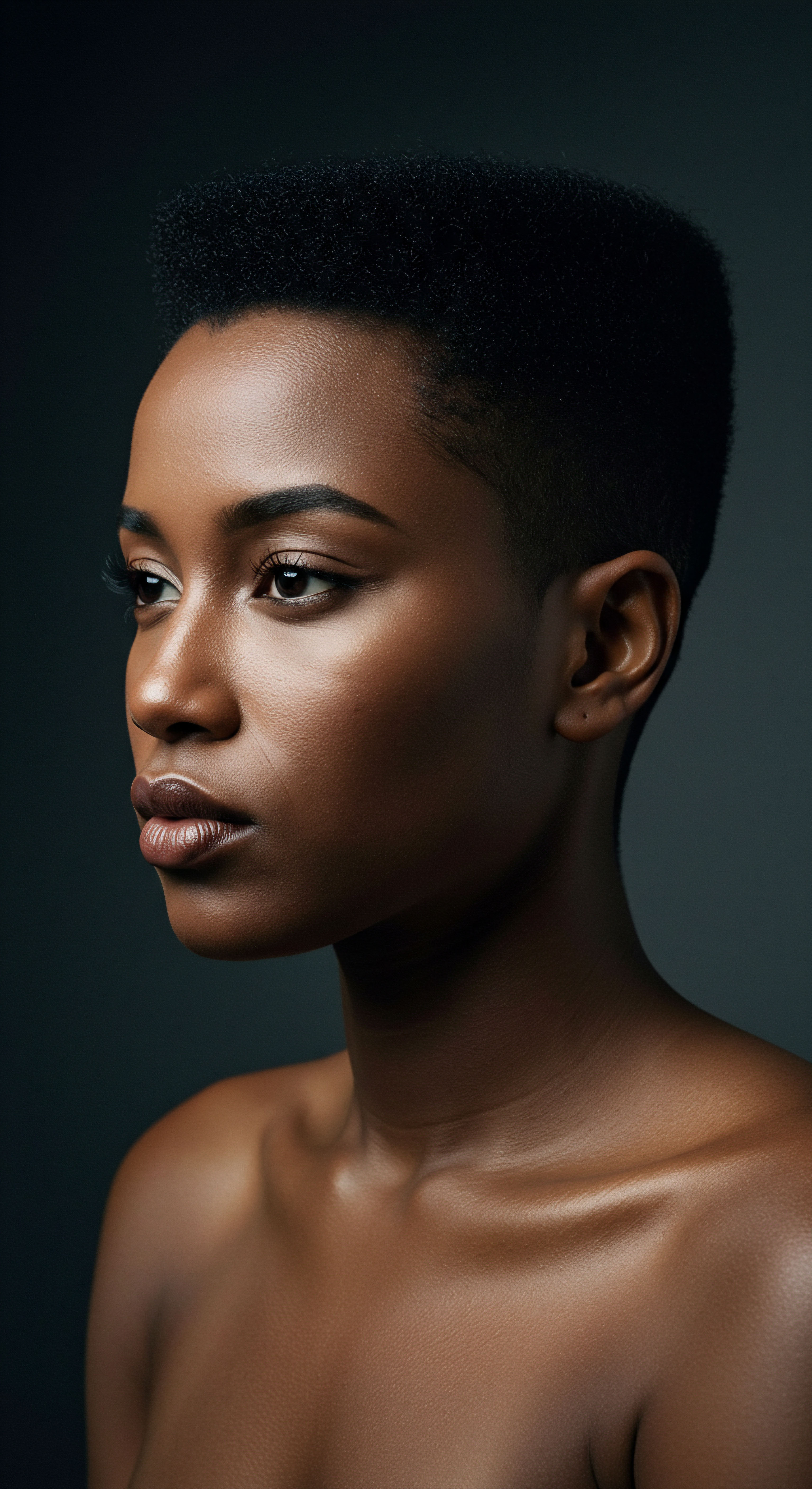
Roots
The quiet hours of night, when the world settles into slumber, hold a subtle yet profound dialogue within our bodies. For those who nurture textured hair, a curiosity often stirs ❉ how does the restorative calm of deep sleep truly touch the vibrancy of our strands? It is a question that leads us into the foundational workings of our being, revealing how rest, particularly its deepest phases, orchestrates the very lifeblood of our scalp.
We speak of the scalp not merely as skin, but as a living canvas, a rich environment where every strand begins its journey. Understanding the intricate dance between sleep and the circulation within this vital space offers a fresh perspective on hair health, one that moves beyond surface treatments to honor the body’s innate wisdom.
The notion that sleep is simply a period of inactivity misses its profound biological purpose. It is a time of intense activity, a carefully choreographed symphony of repair and regeneration. Our hair, too, participates in this nocturnal rhythm, its follicles responding to the systemic shifts that occur when we surrender to rest. This interplay is far from a simple cause and effect; it is a complex, reciprocal relationship where the quality of our sleep influences the scalp’s capacity to nourish, and in turn, a well-supported scalp can contribute to a more harmonious sleep cycle.

The Hair Follicle and Its Nourishment Network
Each hair strand springs from a tiny, yet remarkably complex, organ nestled within the skin ❉ the Hair Follicle. These miniature powerhouses are not isolated entities; they are deeply connected to the body’s vast circulatory system. A dense network of tiny blood vessels, known as Microcirculation, surrounds each follicle, acting as its dedicated delivery service.
This network supplies the oxygen, vitamins, minerals, and other essential nutrients required for cell division and protein synthesis, the very building blocks of hair. Without an adequate, consistent supply of these vital elements, hair growth can falter, leading to weaker strands, slowed growth, or even increased shedding.
The vitality of this microcirculatory system is paramount. It ensures that metabolic waste products are carried away, maintaining a clean and balanced environment for the follicles to thrive. When this delicate balance is disturbed, perhaps by stress or systemic imbalances, the consequences can manifest in the visible health of our hair. The scalp, therefore, is not merely a foundation but an active participant in the health of our hair, reliant on a robust and responsive blood supply.
Deep sleep orchestrates a vital internal symphony of repair and regeneration, directly influencing the scalp’s ability to nourish each hair follicle.

Sleep Stages and Physiological Shifts
Sleep is not a uniform state; it progresses through distinct stages, each with its own unique physiological signature. These stages are broadly categorized into Non-Rapid Eye Movement (NREM) sleep, which comprises stages N1, N2, and N3 (often referred to as deep sleep or slow-wave sleep), and Rapid Eye Movement (REM) sleep. Each stage brings about specific changes in heart rate, blood pressure, body temperature, and indeed, blood flow throughout the body, including the scalp.
- NREM Sleep ❉ During the deeper phases of NREM sleep, particularly N3, the body enters a state of profound rest and repair. Heart rate and blood pressure generally decrease and become more steady. This period is associated with increased cell turnover and tissue repair throughout the body. For the brain, there are significant changes in blood flow, with studies showing that cerebral blood flow is generally lowest during NREM sleep. However, this reduction in overall brain blood flow might be part of a coordinated effort to facilitate waste clearance and allow for restorative processes. While direct, specific measurements of scalp blood flow during each precise sleep stage are complex, the systemic changes during deep NREM sleep create an environment conducive to cellular regeneration and nutrient delivery to peripheral tissues, including the scalp.
- REM Sleep ❉ In contrast, REM sleep is characterized by increased brain activity, often mirroring waking states, and is when most dreaming occurs. Heart rate and blood pressure become more variable, similar to daytime patterns. Blood flow to the brain tends to increase during REM sleep, sometimes exceeding waking levels. While the primary focus of REM sleep’s circulatory shifts is often the brain, the overall physiological activation during this stage also contributes to the dynamic regulation of blood flow throughout the body.
The body’s internal clock, the Circadian Rhythm, profoundly influences these sleep stages and the associated physiological changes. This rhythm dictates when we feel sleepy and awake, and it also plays a role in the cyclical nature of hair growth. Disruptions to this natural rhythm, whether from irregular sleep schedules or chronic sleep deprivation, can send confusing signals throughout the body, potentially impacting the delicate balance required for optimal scalp circulation and hair vitality.
| Sleep Stage NREM Stage 1 (N1) |
| Key Characteristics Lightest sleep, transition from wakefulness, brief. |
| Blood Flow Dynamics Beginning of general slowing, less dramatic changes. |
| Sleep Stage NREM Stage 2 (N2) |
| Key Characteristics Slightly deeper, body temperature drops, heart rate slows. |
| Blood Flow Dynamics General decrease in systemic blood pressure and heart rate. |
| Sleep Stage NREM Stage 3 (N3, Deep Sleep) |
| Key Characteristics Deepest, most restorative sleep, slow brain waves. |
| Blood Flow Dynamics Significant reduction in heart rate and blood pressure; cerebral blood flow generally lowest. |
| Sleep Stage REM Sleep |
| Key Characteristics Dreaming occurs, brain activity resembles wakefulness. |
| Blood Flow Dynamics Heart rate and blood pressure become variable, cerebral blood flow increases. |
| Sleep Stage These systemic changes influence the delivery of nutrients and oxygen to peripheral tissues, including the scalp. |

Ritual
The quest for lustrous hair often leads us to consider external applications, yet the quiet wisdom of daily and nightly practices holds a profound, often underestimated, power. As the day yields to dusk, our personal rituals surrounding rest become more than mere habits; they transform into a conscious act of care, a nurturing gesture for our entire being, including the often-overlooked landscape of our scalp. The way we prepare for sleep, the quality of that rest, and the intentional choices we make for our hair during these hours directly influence the vitality of our scalp’s blood flow, laying the groundwork for thriving strands.
Think of the evening as a transition, a gentle descent from the day’s demands into a state of renewal. For textured hair, this period is particularly significant, as protective measures taken before sleep can minimize friction, preserve moisture, and create an optimal environment for the scalp’s nocturnal regenerative processes. The link between our sleep routines and the very circulation beneath our hair is not a mystical concept, but a tangible, biological connection that, once understood, empowers us to cultivate healthier hair from within.

Nighttime Scalp Stimulation and Circulation
The act of preparing for sleep can be a powerful opportunity to support scalp circulation. Gentle scalp massage, performed as part of a nightly ritual, can encourage blood flow to the hair follicles. This physical stimulation, when done with a light touch and without undue pressure, helps bring nutrient-rich blood closer to the surface of the scalp. While direct scientific measures of increased scalp blood flow from a casual nightly massage are still being refined, the anecdotal evidence and the physiological principles of touch and localized circulation point to its benefits.
A study in 2016, though small, showed that a four-minute daily scalp massage over 24 weeks increased hair thickness in healthy men. This suggests a positive correlation between consistent scalp stimulation and improved hair parameters, likely mediated by enhanced blood supply.
Consider incorporating a few drops of a light, nourishing oil, perhaps infused with stimulating botanicals, into your routine. This can enhance the experience, allowing your fingertips to glide smoothly across the scalp. The warmth generated by the massage itself, combined with the potential properties of certain oils, can contribute to a feeling of invigoration, a subtle invitation for blood to flow freely.

The Role of Sleep Quality in Vascular Health
Beyond direct stimulation, the overall quality of our sleep holds sway over the health of our vascular system. Deep sleep, in particular, is a period when the body actively regulates blood pressure and heart rate, contributing to overall cardiovascular health. When sleep is consistently disrupted, the body can experience increased levels of stress hormones, such as Cortisol.
Elevated cortisol can have a constricting effect on blood vessels, potentially reducing the efficient delivery of oxygen and nutrients to hair follicles. This can prematurely shift hair follicles from their active growth phase into a resting or shedding phase, contributing to thinning or hair loss over time.
A consistent sleep schedule, therefore, is not merely about feeling rested; it is a foundational practice for maintaining hormonal balance and supporting the circulatory system’s optimal function. When we honor our body’s need for consistent, quality sleep, we are indirectly providing our scalp with the consistent, healthy blood flow it requires.
Consistent, quality sleep is a foundational practice for maintaining hormonal balance and supporting optimal circulatory function for hair health.

Protective Styling and Nighttime Environment
For textured hair, nighttime care extends to protecting the strands themselves. Leaving hair loose or unprotected during sleep can lead to friction against pillows, causing breakage, tangles, and even stress on the scalp. This mechanical stress, over time, could potentially impede the delicate microcirculation, especially if tension is consistently applied to certain areas.
The use of protective styling, such as loose braids, twists, or pineappling, minimizes direct contact with bedding. Pairing this with a silk or satin bonnet, scarf, or pillowcase further reduces friction, preserving moisture and preventing unnecessary strain on the hair follicles. These practices create a gentle, undisturbed environment, allowing the scalp’s circulatory system to function optimally without external impedance.
- Loose Braids or Twists ❉ Sectioning hair into large, loose braids or twists before bed helps keep strands contained, reducing tangles and friction. This also helps maintain moisture within the hair.
- Pineappling ❉ Gathering hair loosely at the crown of the head with a soft scrunchie (creating a “pineapple” shape) keeps the bulk of the hair elevated and away from direct contact with the pillow. This is particularly useful for preserving curl patterns.
- Silk or Satin Protection ❉ Sleeping on a Silk Pillowcase or wearing a Satin Bonnet or scarf creates a smooth surface that minimizes friction. Unlike cotton, these materials do not absorb moisture from the hair, helping to maintain its hydration and reduce dryness, which can contribute to breakage.
The thoughtful consideration of our nighttime hair routine becomes an integral part of supporting scalp health. By creating a peaceful, protective haven for our hair while we sleep, we are not only preserving its external beauty but also quietly supporting the internal mechanisms that keep our scalp nourished and our strands strong. This mindful approach transforms simple acts into rituals of profound care.

Relay
Stepping beyond the immediate observations, how does the quiet synchronicity of deep sleep truly orchestrate the complex physiological signals that govern scalp blood flow, extending its influence into the very architecture of hair vitality? This question beckons us into a deeper understanding, one that connects the cellular whispers of our internal world with the visible vibrancy of our strands. It requires us to consider the interplay of neurobiology, hormonal rhythms, and the often-unseen dance of microvasculature, revealing a sophisticated system where sleep is not merely rest, but a dynamic, active participant in our scalp’s well-being.
The true depth of this connection lies in the intricate feedback loops that link our sleep cycles to systemic functions, particularly those regulated by the autonomic nervous system. It is here, at the crossroads of our conscious and unconscious biological processes, that we uncover the profound implications of restorative sleep for the scalp’s circulatory health and, by extension, the sustained life of textured hair. This exploration moves beyond simple correlations, seeking to understand the precise mechanisms and broader contexts that underscore this vital relationship.

The Autonomic Nervous System and Scalp Perfusion
The Autonomic Nervous System (ANS) acts as the body’s silent conductor, regulating involuntary functions such as heart rate, blood pressure, and indeed, blood flow to various tissues, including the scalp. It comprises two main branches ❉ the sympathetic nervous system, associated with “fight or flight” responses, and the parasympathetic nervous system, linked to “rest and digest” states. During sleep, particularly the deeper NREM stages, the parasympathetic system tends to dominate, leading to a general reduction in sympathetic activity.
This shift in autonomic balance during deep sleep influences peripheral blood flow. While direct, continuous monitoring of scalp blood flow during specific sleep stages in humans is challenging, the systemic changes observed during deep sleep — such as lowered heart rate and blood pressure — suggest a state conducive to less constricted blood vessels and more stable circulation. Conversely, chronic sleep deprivation or fragmented sleep can lead to sympathetic overactivity, resulting in vasoconstriction (narrowing of blood vessels). This sustained constriction can reduce the delivery of oxygen and nutrients to the hair follicles, potentially impeding their metabolic processes and growth cycles.
Consider the profound impact of this delicate balance. The scalp’s vascular bed is a dynamic environment, responsive to signals from the ANS. A scalp experiencing persistent sympathetic dominance due to inadequate sleep might exhibit reduced microcirculation, leaving hair follicles in a state of chronic undersupply. This can contribute to issues like hair thinning and reduced hair vitality over time.

Hormonal Orchestration and Cellular Repair During Sleep
Deep sleep is a critical period for hormonal regulation and cellular repair throughout the body, processes that directly influence scalp blood flow and hair health. Key hormones, such as Melatonin and Growth Hormone, are released or become more active during specific sleep stages.
- Melatonin ❉ Often known as the “sleep hormone,” melatonin is produced by the pineal gland in response to darkness and helps regulate our circadian rhythm. Beyond its role in sleep, melatonin also acts as a powerful antioxidant and has been shown to have receptors within hair follicles themselves. Research suggests that melatonin can prolong the Anagen Phase (the active growth phase) of the hair cycle and protect follicles from oxidative stress. While not directly increasing blood flow, its protective and growth-promoting actions create a healthier environment for follicles, making them more receptive to the nutrients delivered by circulation. Lower melatonin levels due to poor sleep can, conversely, hinder hair growth.
- Growth Hormone ❉ Secreted primarily during deep NREM sleep, growth hormone plays a vital role in cell regeneration and tissue repair across the body. This includes the cells within hair follicles, which undergo rapid division during the anagen phase. Adequate growth hormone levels support the metabolic activity of these cells, which in turn requires a robust blood supply. Disruptions to deep sleep can therefore compromise the body’s ability to produce and utilize growth hormone effectively, potentially slowing down hair growth and overall cellular repair processes in the scalp.
The systemic inflammatory response is also modulated by sleep. Chronic sleep deprivation can lead to increased levels of pro-inflammatory cytokines, which can contribute to inflammation in various tissues, including the scalp. Scalp inflammation can negatively affect hair follicles, potentially constricting blood vessels and hindering nutrient delivery. A healthy, restorative sleep cycle helps to regulate these inflammatory pathways, fostering a more peaceful environment for hair growth.
The body’s intricate hormonal balance and cellular repair mechanisms, profoundly active during deep sleep, directly support scalp blood flow and hair follicle vitality.

A Deeper Look at Circulatory Fluctuations in the Brain and Scalp
While much of the research on sleep and blood flow focuses on the brain, the scalp, as an external tissue, also experiences its own set of circulatory dynamics. Studies on cerebral blood flow during sleep have revealed fascinating patterns. For example, during NREM sleep, there are large increases in cerebral blood volume and arteriole diameter compared to the awake state, significantly larger than those evoked by sensory stimulation. These dilated blood vessels and increased blood flow are believed to aid in clearing metabolic waste products from the brain.
While the direct translation of these brain-specific findings to the scalp is not a perfect one-to-one correlation, they underscore the active and dynamic nature of blood flow regulation during sleep. The body prioritizes restorative processes, and an optimized circulatory system is central to this. If the brain is actively engaged in fluid dynamics and waste removal, it stands to reason that other peripheral tissues, including the scalp, benefit from the systemic support for circulation and cellular repair that deep sleep provides.
Consider a compelling data point from a 2023 study published in the European Heart Journal – Open, which found that sleeping less than five hours a night was associated with a 74% higher likelihood of developing Peripheral Artery Disease (PAD) compared with sleeping seven to eight hours. While PAD primarily affects arteries in the legs, restricting blood flow to the limbs, this finding highlights a broader, systemic vulnerability of the circulatory system to chronic sleep deprivation. If insufficient sleep can compromise macro-circulation in major limbs, it is reasonable to consider its potential impact on the delicate microcirculation of the scalp, even if the direct causal link for hair health is still being explored. This systemic circulatory stress could indirectly contribute to a less optimal environment for hair follicle nourishment.
The profound connection between deep sleep and scalp blood flow is not a singular, isolated event, but a complex interplay of neural, hormonal, and vascular mechanisms. It is a testament to the body’s holistic design, where the quality of our rest directly influences the vibrancy of our hair, urging us to recognize sleep as a cornerstone of comprehensive hair wellness.

Reflection
As we draw this exploration to a close, a gentle understanding settles ❉ the journey to vibrant, thriving textured hair extends far beyond the topical, reaching into the very rhythms of our nightly rest. The quietude of deep sleep, with its orchestrated shifts in blood flow, hormonal balance, and cellular repair, stands as a powerful, often unsung, ally in our hair’s vitality. It beckons us to consider our routines not as mere habits, but as opportunities for profound self-care, where honoring our need for rest becomes a loving act for our scalp and strands.
This knowledge encourages a mindful approach, one that recognizes the interconnectedness of our internal landscape with our external appearance. When we choose to prioritize consistent, restorative sleep, we are not only nurturing our overall well-being but also cultivating a hidden garden within our scalp, where blood flows freely, nutrients arrive abundantly, and each hair follicle is given the optimal conditions to flourish. May this deeper insight inspire a gentle revolution in your hair care, one rooted in the wisdom of rest.

References
- Ali, D. (Medically Reviewed). Sleep and Hair Growth – What’s the Connection? HHC Clinics.
- HairFree & HairGrow. (2023). Sleep and Hair Loss. Relationship Explained.
- Hims, G. (2023). Topical Melatonin Hair Growth ❉ What to Know. Good Health by Hims.
- AAYNA Clinic. (2024). The Power of Microcirculation for Healthy Hair.
- Shetty, R. (2025). Needle-Free Hair Restoration ❉ The Future of Scalp Health.
- Centre Clauderer. (n.d.). Hair and sleep ❉ the importance of the night for hair health.
- Hims, G. (2024). Does Lack of Sleep Cause Hair Loss? Good Health by Hims.
- Cinik, A. (n.d.). Hair Follicles ❉ Definition, Diseases and Treatments.
- Miteva, M. & Zata, A. (2016). Integrative and Mechanistic Approach to the Hair Growth Cycle and Hair Loss. PMC.
- Top Doctors. (2024). What are Polynucleotide Injections for Hair Restoration?
- Active Concepts. (2025). Biogenic Caffeine-210 WS ❉ The Ultimate Scalp Care Active for Hair Growth & Circulation.
- Lewis, L. (2019). Deep Sleep Makes Waves for CSF. ALZFORUM.
- Treatment Rooms London. (2024). Can A Lack of Sleep Cause Hair Loss?
- MONPURE. (2024). Hair Loss ❉ Is Lack of Sleep Stunting Growth?
- Dr. Batra’s. (n.d.). How Sleep Is Affecting Your Hair?
- Alshama, R. F. et al. (2024). Cerebral blood flow in sleep ❉ A systematic review and meta-analysis. Sleep Medicine Reviews, 77, 101977.
- Vetrugno, R. et al. (2019). Autonomic dysfunction in sleep disorders. MedLink Neurology.
- City Skin Clinic. (n.d.). Topical Melatonin Serum for Hair Loss.
- Yuan, S. (2023). Short-term sleep deprivation doubles risk of blocked leg arteries ❉ Research. European Heart Journal – Open.
- Trichology. (2024). Discover How Melatonin Can Promote Hair Growth & Fight Hair Loss.
- Besedovsky, L. et al. (2019). Cardiovascular, Inflammatory and Metabolic Consequences of Sleep Deprivation. Sleep Medicine Reviews, 43, 137-148.
- Typology. (2024). The consequences of a lack of sleep on your hair.
- Sani, M. (2023). Hair Cortisol Concentration as a Biomarker of Sleep Quality and Related Disorders. PMC.
- Sanusi, H. (2024). Male Balding Is Associated with An Increased Risk of Sleep Disturbances.
- Kim, S. W. et al. (2022). Sleep disturbance in alopecia areata ❉ A cross‐sectional study. Journal of Dermatology, 49(4), 481-486.
- Medical News Today. (2019). How lack of sleep harms circulation.
- Sleep Centers of Middle Tennessee. (2021). Can Sleep Apnea Cause Hair Loss?
- Sleep Centers of Middle Tennessee. (2025). Peripheral Vascular Disease and Sleep ❉ How Poor Circulation Affects Rest.
- Volkov, M. S. et al. (2017). Theoretical model of temperature regulation in the brain during changes in functional activity. Journal of Neuroscience Methods, 290, 101-112.
- European Society of Cardiology. (2023). Short sleep duration at night associated with increased risk of peripheral artery disease.
- Xu, J. et al. (2000). Noninvasive Determination of Brain Tissue Oxygenation during Sleep in Obstructive Sleep Apnea. American Journal of Respiratory and Critical Care Medicine, 162(2), 522-527.
- Cleveland Clinic. (2022). Dysautonomia ❉ Causes, Symptoms and Treatments.
- Wimpole Clinic. (2025). Can Lack of Sleep Cause Hair Loss?
- Diekelmann, S. & Born, J. (2010). The memory function of sleep. Nature Reviews Neuroscience, 11(2), 114-126.
- My CHYP. (2023). The Landscape of Our Autonomic Nervous System.
- Gotman, J. et al. (2015). Scalp and hippocampal sleep correlates of memory function in drug-resistant temporal lobe epilepsy. ResearchGate.
- Turner, K. L. et al. (2020). Blood Flow ❉ Supplying the sleeping brain. eLife, 9, e64597.
- Penn State University. (2021). Increased blood flow during sleep tied to critical brain function.
- WebMD. (2024). Sleep ❉ What Happens to Body Temperature, Brain Activity, and Breathing.
- Boston University. (2019). Cerebrospinal Fluid “Brain Washing” During Sleep. The Brink.
- Chokroverty, S. (2003). Sleep ❉ Physiology, Investigations, and Medicine. Springer.
- Hindustan Times. (2025). Sleep better, live better ❉ Study reveals surprising benefits of deep sleep for your brain’s health.
- Michigan State University Libraries. (n.d.). Electronic Medical Books ❉ E-Books by Subject.
- Schoch, S. F. et al. (2021). Dynamic coupling between the central and autonomic nervous systems during sleep ❉ a review. Sleep Medicine Reviews, 58, 101490.
- Cleveland Clinic. (2022). Autonomic Nervous System ❉ What It Is, Function & Disorders.
- Nova Science Publishers. (n.d.). Sleep – Physiology, Functions, Dreaming and Disorders.
- Banks, S. & Dinges, D. F. (2007). Behavioral and Physiological Consequences of Sleep Restriction. Sleep Medicine Clinics, 2(3), 503-519.
- Elsevier Health. (n.d.). Sleep Medicine Books, eBooks & Journals.